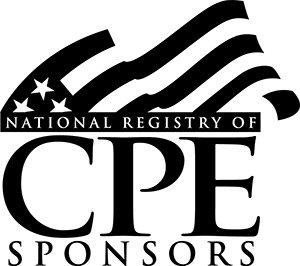What Sponsors Need to Know
AS A CPE PROVIDER, WHAT ARE MY RESPONSIBILITIES FOR ATTENDANCE MONITORING AND RECORD KEEPING FOR A CPE PROGRAM?
CPE program sponsors are required to monitor group learning participants to assign the correct number of CPE credits. A participant’s self-certification of attendance alone is not sufficient.
For the Group Live delivery method, the most common method of attendance monitoring is the use of sign-in/sign-out attendance logs. However, that method may not be the best choice for every CPE event scenario. We have had sponsors use proctors/event administrators to monitor attendance; use stickers on attendance sheets for attendance at individual sessions within an event; use code submissions through mobile devices using technology such as Poll Everywhere; and use bar code scanning for large events. Attendance monitoring methods are at the sponsor’s discretion. The key is that the attendance monitoring should provide the CPE program sponsor with a level of comfort, and ensure that the CPE credits awarded to a participant are accurate. For the Group Internet Based delivery method, CPE program sponsors must employ some type of real time monitoring mechanism to verify that participants are engaged for the duration of the course. The monitoring mechanism must be of sufficient frequency and lack predictability. Also, the monitoring mechanism must employ at least three instances of interactivity completed by the participant per CPE credit.
CPE program sponsors are required to retain adequate documentation regarding each CPE program event for a minimum of five years. Specific details on items to retain can be found in Standard No. 24. National Registry staff review this documentation during compliance audits. When reviewers are unable to confirm attendance, the lack of adequate documentation becomes an audit deficiency. At a minimum, sponsors must retain the following:
- Records of participation
- Dates and locations
- Names and credentials of author/instructor, author/developer, and reviewer, as applicable. For the CPA and tax attorney acting as an author/instructor, author/developer, and reviewer for accounting, auditing, or tax program(s), the state of licensure, license number, and status of license should be maintained. For the enrolled agent acting in such capacity for tax program(s), information regarding the enrolled agent status should be maintained.
- Number of CPE credits earned by participants
- Results of program evaluation
- Information related to course development such as copies of program materials, evidence that the program materials were developed and reviewed by qualified parties, and a record of how CPE credits were determined.
Additionally, Standard No. 24 provides specific guidance on the documentation to retain by CPE program sponsors who are using the self-study delivery method for the determination of CPE credits using pilot testing or the word count formula methods.
Adherence to the Standards, NASBA policies and procedures shows the public that CPE program sponsors have an ongoing commitment to provide quality CPE programs. Moreover, there are supplementary benefits of proper documentation.
- Adds more value to CPE programs
- Cleaner and faster compliance audits
- Easier transition for employees with NASBA-compliance responsibilities
- Enhanced customer service to CPA participants

